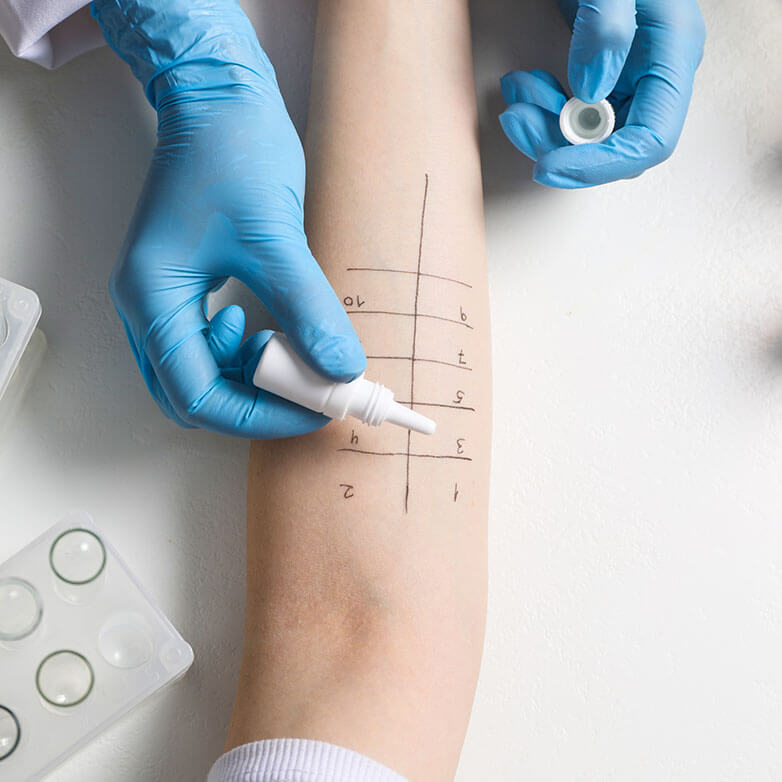
It is important to determine potential allergens that your body may react negatively to from a young age, especially for young children, to ensure certain foods or activities do not hinder you or your children’s quality of life.
Skin pricking tests are a common diagnostic tool used to identify allergic reactions to specific substances, such as pollen, pet dander, or foods. During the test, a small amount of common allergens is applied to the skin’s surface, usually on the forearm or back, and then a tiny prick is made through the allergen to allow it to enter the skin. This method helps determine if a person has an immediate allergic response.
The procedure is quick and generally well-tolerated, with results typically available within 15 to 20 minutes. A reaction, such as a small, raised bump or redness on site, indicates sensitivity to the allergen. Skin pricking tests are useful for diagnosing allergies and guiding treatment plans, including avoidance strategies or immunotherapy.
Intradermal testing helps identify allergic reactions by injecting small amounts of allergens just below the skin’s surface. This test is particularly useful for detecting sensitivities to substances that may not be revealed through other allergy tests, like skin pricking. During the procedure, a fine needle is used to introduce a tiny amount of allergen into the dermis, the layer of skin just beneath the surface.
The test is typically performed on the forearm and involves monitoring the injection site for a reaction. A localised reaction, such as swelling or redness, indicates an allergic sensitivity to the tested substance. Intradermal testing is often used when more detailed information is needed after a skin prick test or when diagnosing complex allergies.
Immunotherapy is designed to reduce allergic reactions by gradually desensitising the immune system to specific allergens. It involves administering controlled doses of allergens over time, either through allergy shots (subcutaneous immunotherapy) or sublingual tablets (sublingual immunotherapy). The goal is to modify the body’s immune response, decreasing the severity of allergic symptoms.
Allergy shots are given as injections, typically transitioning from frequent doses to less frequent injections. Sublingual immunotherapy involves placing tablets or drops under the tongue daily. Both methods aim to retrain the immune system to tolerate allergens better.
Service Care 2
Lorem ipsum dolor sit amet, consectetuer adipiscing elit. Aenean commodo ligula eget dolor. Aenean massa. Cum sociis natoque penatibus et magnis dis parturient montes, nascetur ridiculus mus. Donec quam felis, ultricies nec, pellentesque eu, pretium quis, sem. Nulla consequat massa quis enim. Donec pede justo, fringilla vel, aliquet nec, vulputate eget, arcu. In enim justo, rhoncus ut, imperdiet a, venenatis vitae, justo. Nullam dictum felis eu pede mollis pretium. Integer









Service Care 3
Lorem ipsum dolor sit amet, consectetuer adipiscing elit. Aenean commodo ligula eget dolor. Aenean massa. Cum sociis natoque penatibus et magnis dis parturient montes, nascetur ridiculus mus. Donec quam felis, ultricies nec, pellentesque eu, pretium quis, sem. Nulla consequat massa quis enim. Donec pede justo, fringilla vel, aliquet nec, vulputate eget, arcu. In enim justo, rhoncus ut, imperdiet a, venenatis vitae, justo. Nullam dictum felis eu pede mollis pretium. Integer
Service Care 4
Lorem ipsum dolor sit amet, consectetuer adipiscing elit. Aenean commodo ligula eget dolor. Aenean massa. Cum sociis natoque penatibus et magnis dis parturient montes, nascetur ridiculus mus. Donec quam felis, ultricies nec, pellentesque eu, pretium quis, sem. Nulla consequat massa quis enim. Donec pede justo, fringilla vel, aliquet nec, vulputate eget, arcu. In enim justo, rhoncus ut, imperdiet a, venenatis vitae, justo. Nullam dictum felis eu pede mollis pretium. Integer

Weekdays: 08:30am — 4:30pm
Suite 25, Sunnybank Specialist Centre, 245 McCullough St, Sunnybank QLD 4109
© Auslon Medical Group 2024 | Web Design by Quikclicks